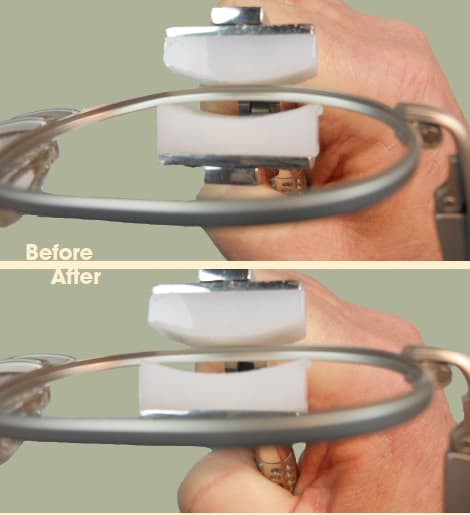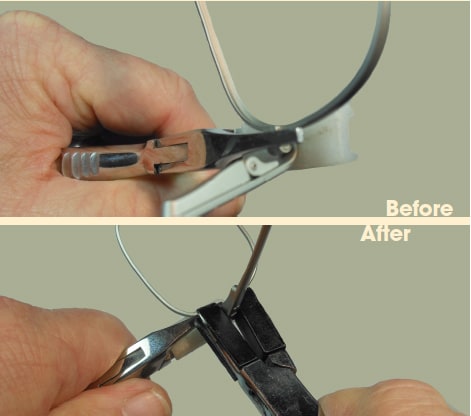fix and fit
Pre–Fitting Eyewear for Today’s Lenses
Alex Yoho, ABOM

Pre-fitting eyewear has always been a good idea, but with today’s lenses, it is more critical. With lens forms trending flatter because of materials and digital enhancements, it’s even a good idea to flatten the curve of the eyewire a bit in some cases.
A typical frame is manufactured with about a six-diopter curve in the eyewire. If your patient has a −4.00 prescription, the base curve of new lenses will be anywhere from plano to +2.00 depending upon the index of refraction.
As the curve of the frame is reduced to accommodate the flatter lens, it will cause the outer edges of the frame to come forward and possibly create a need for a longer temple to be ordered.
Of course, digitally enhanced lenses are taking fitting to a new realm, taking into consideration things like face form, pantoscopic tilt, and vertex measurements to produce optically superior lenses. In the past, a good optician could rough a frame into an approximate adjustment and take measurements, knowing that if a seg height was a millimeter off, it could easily be adjusted to correct the situation.
With digitally surfaced lenses, however, subtle nuances of frame adjustment are taken into consideration. So it’s important to pre-fit a frame exactly as it should be worn to get the most benefit for the patient.
STEP BY STEP
FLATTENING CURVE. The best place to start is just a slight reduction/flattening of curve using curving pliers in a reversed fashion with equal but slight pressure placed all along the eyewire on both sides. With a little practice, this can become routine.
It is desirable to have some face form, even with very flat lenses, but not an excessive amount. If you put a straight edge across the back of the frame (or hang it over a table edge) touching the back of each endpiece, there should be about two to three millimeters of space from the back of each side of the bridge to the straight edge.
PANTOSCOPIC TILT. The next step is adjusting the pantoscopic tilt. Some frames do not allow much adjustment in this area, so be sure it either fits well to begin with or has the potential for adjustment before committing to using it.
| AUTOMATED MEASURING |
|---|
The new automated measuring instruments can take amazingly accurate measurements in about 20 seconds, giving all the information you will need for the most advanced lenses. They even take measurements impossible to do manually, such as eye rotation center, head posture, and visual behavior. In addition, many of these instruments can be used as sales aids to show lens thickness options and AR simulation, or even as a try-on camera. 
(Above) If the curve of the lens bevel is flatter than the curve of the frame, use curving pliers and lightly squeeze all along the eyewire to flatten (Below) Always use bracing pliers on the eyewire barrels to prevent breakage. Bend the endpiece down using padded pliers to keep from marring the frame 
|
Pantoscopic tilt is correct when there is equal space from the top of the frame to the brow and from the bottom of the frame to the cheek. This ensures that the lens is perpendicular to the visual axis and a good fit that won’t rub on the brow or cheeks. Be careful, however, because increasing pantoscopic angle can bring a temple forward, requiring a longer temple to be ordered.
NOSEPADS. With the gross adjustments made on the frame, attention should turn next toward nosepads. If the frame has a fixed bridge, the fit should have been determined at the first try on, and any frame not fitting perfectly on the bridge should have been eliminated. Ideally, nosepads should lay flat on the side of the nose, and the width between them should allow for about a millimeter clearance to the frame on each side without raising or lowering the frame.
If the frame sits too close at the top and bottom, this is the time to adjust the nosepads back to increase the vertex distance. Temples can be roughed in if needed to keep the frame from slipping during measurements, but they don’t need to be perfected until the final delivery.
MEASUREMENTS. Now with your frame perfectly pre-fit, you are ready to take all necessary measurements, either manually or utilizing one of the new automated measuring instruments. Your patients will be impressed with the new technology, and your job will just have been made a lot easier. EB



